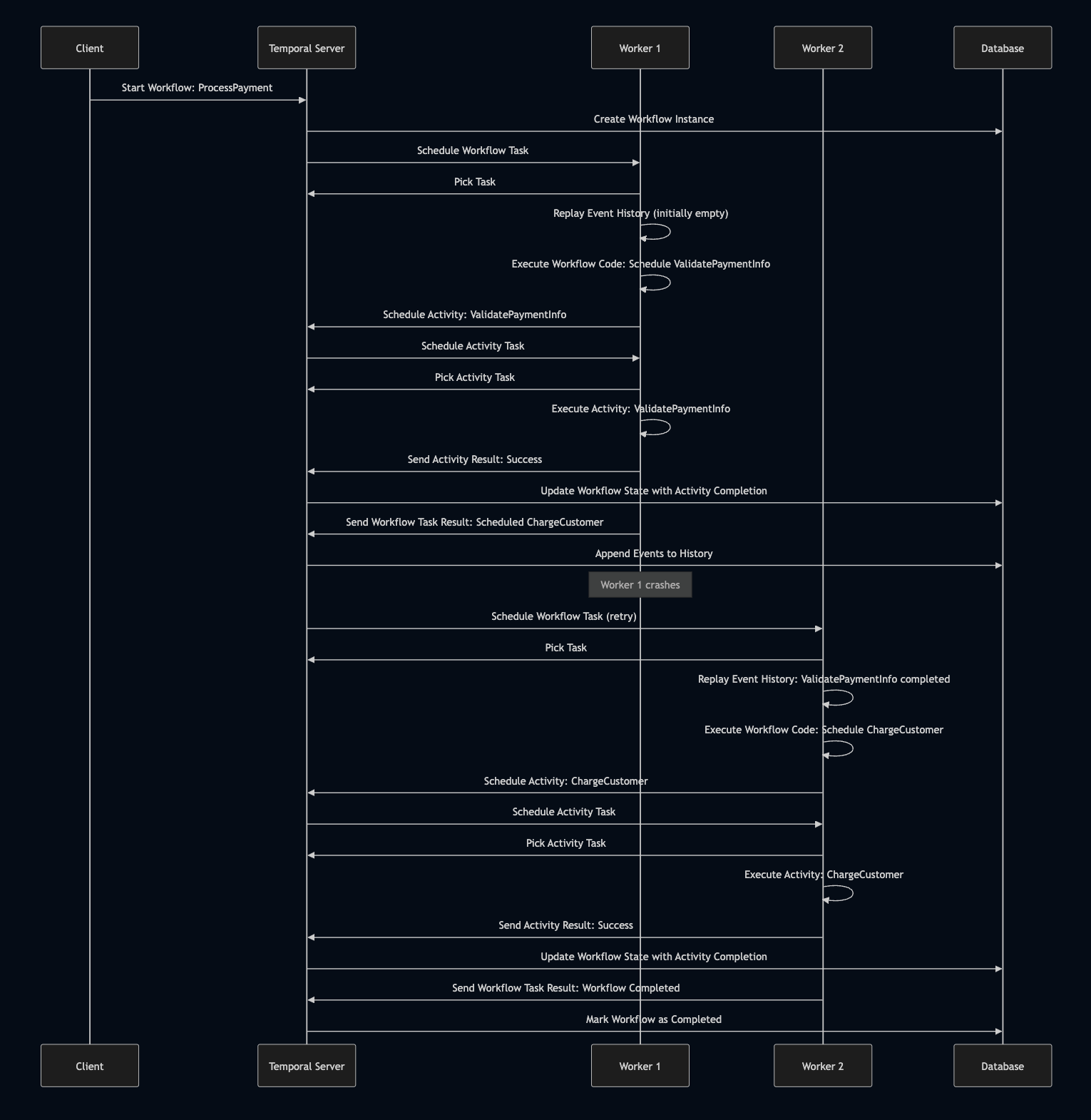Temporal in Ten Minutes
Learn how Temporal makes distributed systems easier by handling fault tolerance, state persistence, and workflow orchestration automatically in just ten minutes.
Mario Guerra
Author

Picture this: It's 2 AM and your e-commerce checkout system just crashed mid-transaction.
Without the right safeguards, chaos would ensue. Customers would be stuck with pending payments. Your database could end up in an inconsistent state. Meanwhile, monitoring alerts would flood your phone demanding immediate attention as the system frantically scrambles to undo what it already did.
What do you do? 😱
If you're using Temporal, the answer is... nothing.
You keep sleeping peacefully, because Temporal automatically detects the crash, recovers the exact transaction state, and seamlessly continues processing from where it left off. No data loss, no duplicate charges, no angry customers.
😴 Sweet Dreams with Temporal
While traditional distributed systems would wake you up at 2 AM with cascading failures, Temporal quietly handles the recovery behind the scenes, ensuring your workflows complete reliably no matter what goes wrong.
But how does this magic actually work? In this post, I'll explain what Temporal is and why it's the secret weapon that lets developers sleep soundly while their distributed systems handle themselves.
What is Temporal?
Think of Temporal as a smart coordinator that manages your business processes and keeps them running smoothly. At its core, Temporal is a platform that ensures your tasks complete reliably, even when things go sideways.
🤔 New to Temporal? The Learning Curve is Real
If you're coming from traditional distributed systems, Temporal requires a mindset shift. Instead of thinking "How do I handle every possible failure?" you think "What should happen when everything works perfectly?" Temporal handles the rest.
🔍 The Git Analogy, Your Key to Understanding Temporal
Think of it like Git for your workflow execution.
Just as Git stores a complete history of commits that you can replay to recreate any point in your codebase, Temporal stores a complete history of events that it can replay to recreate any point in your workflow.
📊 Git vs Temporal Comparison
| Git | Temporal | |
|---|---|---|
| 🗂️ Stores: Code commits | 📝 Stores: Workflow events | |
⏮️ Replays: git checkout <commit> |
🔄 Replays: Event history replay | |
| 🎯 Result: Recreates codebase state | ✅ Result: Recreates workflow state |
This is how Temporal achieves its reliability. When something crashes, it doesn't lose your work. It just "checks out" the exact state where you left off and continues from there.
⚡ What Makes Temporal Special
- 🛡️ Fault tolerance → Your workflows automatically recover from failures
- 💾 State persistence → Nothing gets lost, even if your entire system crashes
- 📈 Scalability → Handle anything from simple tasks to complex, multi-step processes
- 🌍 Language flexibility → Works seamlessly with Go, Java, Python, and more
🎯 Think of it this way:
Temporal is like having a project manager that never sleeps, never forgets, and never gives up on completing your tasks.
Why Should You Care About Temporal?
You might be wondering, "Why not just use existing tools or build retry logic myself?"
Here's why Temporal stands out:
🔧 Easier Failure Handling
Instead of writing complex retry logic and error handling for every service, Temporal handles all of this automatically. Failed tasks? Temporal retries them. Network timeouts? Temporal manages them. Service crashes? Temporal picks up where you left off.
⏳ Long-Running Workflows
Some processes take hours, days, or even months to complete. Traditional approaches struggle with this, but Temporal excels at managing long-running workflows without breaking a sweat.
👀 Real-Time Visibility
Ever wondered what's happening inside your distributed system? Temporal provides real-time visibility into your workflows, showing you exactly where things are and what's happening at any moment.
👨💻 Developer Experience
Temporal lets you write workflow logic in your preferred programming language using familiar patterns. No need to learn complex configuration languages or wrestle with XML files.
💡 SDK Integration Benefits
Whether you're using Go, Java, Python, TypeScript, or .NET, Temporal's SDKs provide idiomatic APIs that feel natural in each language ecosystem. You're not learning a new framework. You're enhancing your existing code with reliability superpowers.
Core Components That Make It Work
Understanding Temporal becomes much easier when you know its key building blocks:
📋 Workflows
These define the sequence of steps in your process. Think of them as the blueprint that describes what needs to happen and in what order.
⚙️ Activities
These are tasks that have side effects, such as calling external APIs, writing to databases, or sending emails. Think of activities as "the risky parts" where network calls can fail or timeouts can occur. Temporal treats these specially with automatic retries, timeouts, and failure handling.
👷 Workers
The processes that execute your workflow and activity code. Workers are like diligent employees that pick up tasks and complete them.
🎛️ Temporal Server
The orchestrator that coordinates everything. It schedules tasks, manages state, and ensures nothing falls through the cracks.
🎯 Pro Tip for Developers
Activities should be idempotent (safe to retry) and focused on a single responsibility. This makes your workflows more reliable and easier to debug when things go wrong.
How Temporal Works Its Magic
Here's where things get interesting. Temporal uses some clever techniques to achieve its reliability:
📚 Event Sourcing
Instead of just storing the current state of your workflow, Temporal records every event that happens (like "task started", "task completed", "error occurred"). This creates a complete history of what transpired.
💾 State Persistence
All these events get saved in a database, ensuring durability. Even if your entire system goes down, nothing is lost.
🔄 Failure Recovery
When a worker crashes, another worker can pick up the task by replaying the event history. But what does "replaying" actually mean?
Remember our Git analogy from earlier? When a new worker takes over, it doesn't just guess where things left off. Instead, it reads through the complete event log (like "payment validation started", "payment validation completed", "charge customer started") and re-executes the workflow code step by step.
⚡ Here's the clever part:
When the workflow code says "validate payment", but Temporal sees that event already happened, it skips the actual validation and just returns the previous result. The workflow continues until it reaches a step that hasn't been completed yet - that's where the new worker picks up the real work.
This replay process rebuilds the exact state the crashed worker was in, ensuring nothing is lost or duplicated.
🎯 Deterministic Execution
Temporal ensures that replaying the same sequence of events always produces the same outcome, providing consistency and predictability.
Visualizing the Flow
Let's see how this works in practice with a payment processing workflow:

🔍 What's Happening Here?
- 🚀 Client initiates the payment workflow
- 🎛️ Temporal Server orchestrates everything and persists state
- 👷 Worker 1 starts processing but crashes after validating payment info
- 🔄 Worker 2 seamlessly takes over by replaying the event history
- 💾 Database stores everything, ensuring nothing is lost
✨ The beautiful part?
All the state management and recovery happens behind the scenes. Your business logic remains clean and focused on what it should do, not how to handle failures.
A Simple Example
Let's imagine you're building a payment processing system with these steps:
💳 Payment Processing Workflow
- ✅ Validate payment information
- 💰 Charge the customer
- 📧 Send a receipt
⚠️ The Traditional Problem
In a traditional system, if your service crashes after charging the customer but before sending the receipt, you might end up charging them again when you restart.
🎯 The Temporal Solution
With Temporal, the framework knows exactly what happened. When the system recovers, it picks up where it left off and sends the receipt without recharging the customer.
This is the power of Temporal. It handles the complex orchestration while you focus on business logic.
Why Developers Love Temporal
Beyond the technical benefits, there's something special about the developer experience that makes Temporal addictive:
🧩 It Just Fits
Temporal doesn't feel like bolting on another framework. Whether you're writing Go microservices, Python data pipelines, or Java enterprise applications, the SDKs feel native to your ecosystem.
🔬 Observability That Actually Helps
Ever tried debugging a distributed workflow that's spread across multiple services? Temporal's Web UI shows you exactly what's happening, when it happened, and why something failed. No more digging through log files across dozen of services.
🎯 Testing Made Simple
Testing workflows used to mean complex test harnesses and mocking time. Temporal's testing frameworks let you write unit tests for workflows and activities just like any other code.
💡 The "Aha!" Moment
Most developers have their Temporal "aha!" moment when they realize they've been overthinking distributed systems. You write your business logic as if it's running on a single machine, and Temporal handles making it distributed, reliable, and scalable.
Getting Started
Ready to experience what thousands of developers already know? Here's your path to Temporal mastery:
📚 Start with the Right SDK
Choose your weapon. Go, Java, Python, TypeScript, or .NET. Each SDK is crafted for that language's ecosystem
🎓 Try the Hello World Tutorial
Nothing beats hands-on experience. The quickstart guides walk you through your first workflow in minutes
👥 Join the Developer Community
Connect with 3,000+ developers already using Temporal on their community forum and Slack
🚀 Identify Your Use Case
Look for processes in your system that involve multiple steps, external API calls, or need to be really, really reliable
Wrapping Up
🌙 No More Sleepless Nights
Distributed systems don't have to be a source of sleepless nights. Temporal makes them manageable by handling the hard parts (fault tolerance, state management, and failure recovery) so you can focus on building great features.
Whether you're building microservices architectures, managing complex business processes, or just want systems that Actually Work™, Temporal offers a paradigm shift that's transforming how developers approach distributed computing.
The best part is that you don't have to take my word for it. Thousands of developers at companies from startups to Fortune 500 enterprises are already sleeping better thanks to Temporal. Your turn to join them.
🚀 Ready to build bulletproof workflows?
Pick your favorite language, grab the SDK, and start building something that won't break at 2 AM.